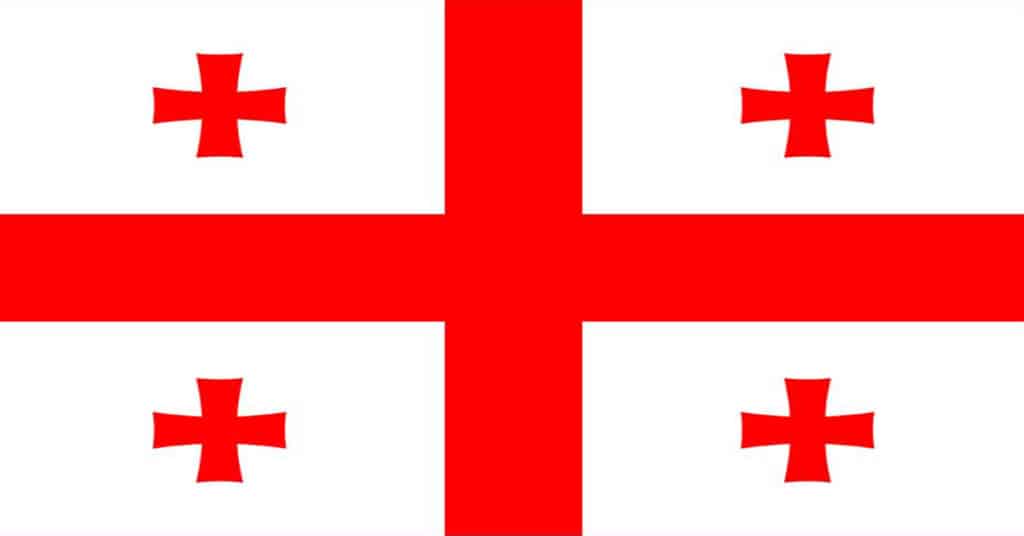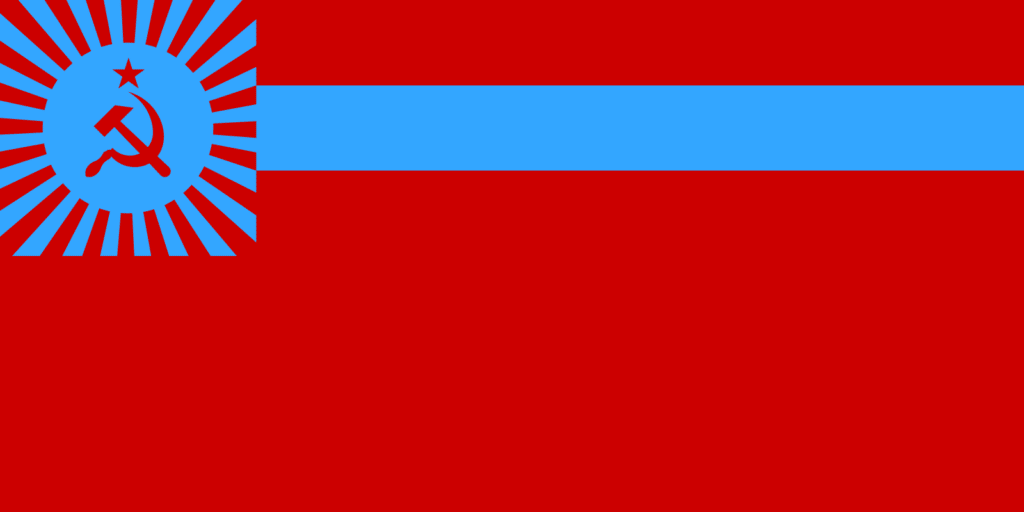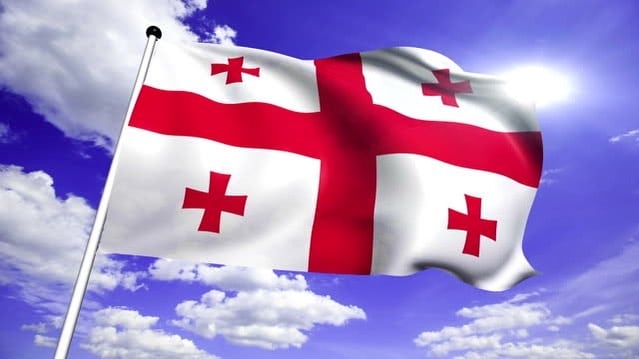
Georgia’s Five Cross Flag is a significant national emblem and symbol of the country and its national religion. The flag consists of a white rectangle with a huge red cross above it that extends to each of the flag’s four edges, creating four squares of white that are each filled by a smaller red cross. The history of the flag, which dates to the fifth century, is quite extensive.
Let’s explore the Georgian flag in more detail by learning about its history and symbolic meaning and check here for the latest time in Georgia and more interesting facts.
First References of Georgian Flag
Early medieval Georgia is linked to one of the earliest references to the Georgian flag. The first Georgia flag is thought to have existed between the fifth and tenth centuries. Around 482-500, Vakhtang I Gorgasali, the King of Iberia, also known as “Kartlis Samepo,” adopted a white flag with a single cross on it.
However, historians are unsure of the exact form and shape of the cross. Some academics think Christianity is less relevant to Gorgasali’s cross than the Hittites and Sumerians. Another Georgian region with a red cross was Tao-Klarjeti. From 888 to 1008, a dark red cross on a white background served as the official flag of the Kingdom of the Georgians. Theocratic Kakheti, the third principality with a related emblem, was ruled by the Episcopi from 787 until 1037.
The next era in the Georgian flag’s history is connected to medieval Georgia, which dates from the 10th century to the 15th century. In 1089–1125, David IV the Builder, the first king of united Georgia, designated a dark red cross flag as the emblem of undivided Georgia. This particular cross was the former flag of the Principality of Tao-Klargeti.

Queen Tamar’s Flag
The red cross flag attained new heights of significance during Queen Tamar the Great’s reign as a result of Georgia becoming the dominant force in the area. Queen Tamar reigned between 1184 and 1213.
The extensive regions between the Caspian and Black Seas were symbolized by the flag, which was formally known as the “Gorgaslian-Davitiani Flag.” Later, the original single-cross flag was changed into the contemporary flag with five crosses by King Giorgi V the Brilliant, who reigned between the years 1314–1346.

Soviet Georgian Flag
Georgia adopted numerous variations of the red Soviet flag throughout the Soviet era, initially adding the name of the Georgian Soviet Socialist Republic. Then a red hammer and sickle with a star in a blue sun in the canton and a blue bar in the top portion of the flag were also presented. In November 1990, just before it proclaimed independence from the Soviet Union, the Georgian government changed the Georgian SSR flag to the flag of the Democratic Republic of Georgia.

Flag Of the Democratic Republic Of Georgia
A flag with a dark red field and black and white bands in the canton was adopted during Georgia’s brief period of independence as the Democratic Republic of Georgia from 1918 to 1921. Ironically, the black and white bands represent both the civilian flag of Prussia and the flag of the Swiss canton of Fribourg, particularly the latter.
The artist Iakob Nikoladze won a competition to design the country’s flag, which led to the creation of the design. After Georgia was incorporated into the USSR in 1921, it was dissolved by the USSR. Georgia adopted a modified version with long black and white bars following the dissolution of the USSR.
The current Georgian flag dates back to the thirteenth century. After that time, Georgia was split up into many regions, each with its own flag. The flag with the five crosses was overlooked because of this. After Georgia gained independence in 1918–21, they brought up the flag issue once more.
The Georgian patriotic movement adopted the present flag after the nation gained independence from the Soviet Union in 1991. The red-on-white Jerusalem cross that was depicted as the flag of Tbilisi on a 14th-century map by Domenico and Francesco Pizzigano led vexillologists to identify the design as the Georgian historical national flag by the late 1990s.

Current Georgian Flag
During that time, the flag’s design was distinct since it represented the nation’s victory logically. It was a tricolor flag with white, black, and dark red colors. Dark crimson symbolized Georgia’s past and the bloodshed throughout their struggles for survival. The reunification of the country was symbolized by black and white. The colors of the Georgian flag are simply red and white. The code for red is RGB 225-0-0, and for white, RGB 225-225-225.
The present period in the Georgian flag’s history is connected to contemporary Georgia, which is from the 20th century. The restoration of Georgia’s independence in 1991 marked the beginning of the flag’s modern era. The five-red cross flags had been frequently used since 1998 during the large-scale demonstrations against Eduard Shevardnadze’s corrupt administration and the Russian military occupation of Georgia.
The restoration of the flag was backed by the majority of Georgians, including the powerful Catholicos-Patriarch of the Georgian Orthodox Church, and a measure to replace the flag was approved by the Georgian Parliament in 1999. However, Eduard Shevardnadze, the president at the time, did not support it. It was adopted as a symbol of the Rose Revolution and of public opposition to Shevardnadze’s administration by the largest opposition group, the United National Movement, which is led by Mikheil Saakashvili, in the early 2000s.
The Georgian Parliament approved a measure in 1999 that would have brought back the five-red cross flag. However, President Shevardnadze vetoed it. Since that time, the flag has served as the symbol of the Mikheil Saakashvili-led Georgian National Movement Party. Following his resounding victory in the 2004 presidential elections, Saakashvili started the process of restoring the five-red cross flag.
After Mikhail Saakashvili won the Georgian presidential election, the current Georgian flag was officially adopted. The Mikhail Saakashvili national movement used the flag before it was approved by Parliament in January 2004.
The Georgian flag itself is a white fabric with five red crosses on it, including a center St. George cross and four Bolnisi crosses in each of the four quadrants. The common Christian emblems that represent Jesus Christ the Savior and the four evangelists are rectangular and have four little crosses on a white background.
Godfrey Bouillon, a crusader, first displayed these universal Christian emblems on his arms in 1099, earning him the title “defender of the Holy Sepulcher.” Since then, Jerusalem, the holiest site in Christianity, has been personified by this heraldic emblem. It goes by three names: the Holy Sign, the Godfrey Bouillon Symbol, and the Jerusalem Emblem.

Symbolic Meaning Of Georgian Flag
The 13th-century Georgian flag’s picture, which was discovered near Tbilisi, was composed of the colors black and white. As a result, they were unable to determine if it was the flag of Georgia or not. The Georgian delegation went to Paris to study the Museum of National Maps in order to ascertain this. He looked at two different kinds of maps from the fourteenth century. These maps included fortifications bearing the name “Tiflis” (Tbilisi) and a flag with five crosses. As a result, experts were certain that Georgia actually owned the black-and-white flag.
Speaking of symbolism, it’s crucial to concentrate on the flag’s colors. They do convey a variety of meanings that are all connected to color symbolism. The majority of the area on the flag is taken up by the color white. But it also serves to encourage chastity, intelligence, and innocence. Those ideas let us fully comprehend the character of the Caucasus — a location where our adherence to principles and traditions is quite strong.
The color red symbolizes blood. As a result, we attribute to it all the qualities associated with life or combat. Red is intended to stand for bravery and valor on the Georgian flag, as determined by the pursuit of justice. But red also symbolizes love and passion.
The crosses serve as a visual reminder of the medieval period. This flag has a seven-century history. The crosses stand for both the nation’s unbreakable unity and the many regions of the country’s land.
The enormous cross, which is also the cross of St. George, the nation’s patron saint, symbolizes the cross of Jesus Christ. The happiness-bringing angels are represented by the four smaller crosses. The flag has four tiny red crosses that date back to the Middle Ages. The flag of the five crosses is another name for the Georgian flag.
By the end of 2021, a recently unearthed coin of King David the Builder bearing an etching of five crosses, placed the Georgian flag in the 12th century. The coin is of utmost significance and provides clear evidence of the use of the Georgian national flag throughout King David IV’s reign, according to the State Council of Heraldry.
Bottom Line
The Five-Cross Flag of Georgia is one of the earliest national flags of the country. Since Georgians have fought for independence and justice throughout their long history, the flag has become a symbol of their struggle. The flag has a significant function and significance in a nation’s history, according to historians. It metaphorically symbolizes the dignity of the nation.